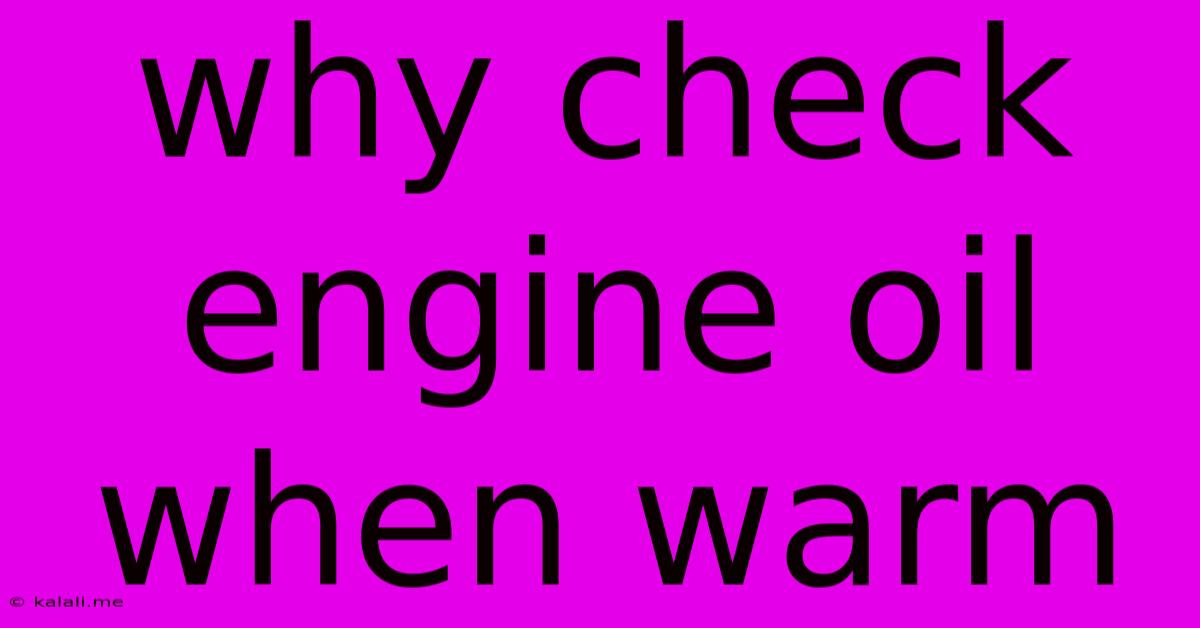Why Check Engine Oil When Warm
Kalali
May 20, 2025 · 3 min read

Table of Contents
Why Check Engine Oil When Warm? A Comprehensive Guide
Checking your engine oil is a crucial part of car maintenance, ensuring your engine runs smoothly and lasts longer. But did you know that the best time to check your oil level is when the engine is warm? This isn't just a random tip; there's a sound mechanical reason behind it. This article will explain why checking your engine oil when warm provides the most accurate reading and help you avoid costly engine repairs.
The Importance of Accurate Oil Level Measurement: Maintaining the correct oil level is vital for engine lubrication and preventing damage. Too little oil leads to insufficient lubrication, causing friction, overheating, and ultimately, engine failure. Too much oil can lead to excessive pressure, potentially damaging seals and causing leaks. An accurate reading is key to avoiding both extremes.
Why Cold Oil Readings Are Inaccurate
When your engine is cold, the oil sits pooled in the oil pan. This means a significant portion of the oil isn't accounted for in your dipstick reading, resulting in a falsely low reading. You might think you need to add oil when you actually don't. Conversely, adding oil based on this inaccurate reading could lead to overfilling.
The Benefits of Checking Warm Oil
Checking your oil after the engine has been run for a short period (around 5-10 minutes) offers several advantages:
- Accurate Measurement: The warm oil circulates throughout the engine, ensuring the dipstick accurately reflects the total oil volume in the system. This gives you a precise reading of your oil level.
- Improved Oil Flow: Warm oil flows more easily, allowing for a more complete draining back into the oil pan before you take the dipstick reading. This ensures a more consistent measurement.
- Identification of Leaks: A warm engine can sometimes reveal subtle oil leaks that are not apparent when the engine is cold. This allows for early detection and prevention of more significant problems.
- Avoids False Readings: Avoids the common mistake of adding too much oil because of a falsely low reading from a cold engine.
Step-by-Step Guide to Checking Warm Engine Oil
- Run the engine: Start your car and let it run for 5-10 minutes. This allows the oil to reach its operating temperature and circulate throughout the engine.
- Turn off the engine: Safely turn off your car and allow it to sit for a few minutes to let the oil settle back down into the oil pan.
- Locate the dipstick: Find your engine oil dipstick (usually yellow or with a handle).
- Remove and wipe the dipstick: Remove the dipstick, wipe it clean with a lint-free cloth, and reinsert it fully.
- Remove and check the level: Remove the dipstick again and check the oil level. It should fall between the minimum and maximum markings.
Understanding Oil Viscosity and Temperature: Oil viscosity (thickness) changes with temperature. Cold oil is thicker, flowing less efficiently. Warm oil is thinner, flowing more freely and providing better lubrication to all engine components. Checking the oil when it’s at its operating temperature gives the truest representation of its viscosity and level.
Conclusion: Warm Oil Checks are Essential
Checking your engine oil when warm provides the most accurate reading, ensuring you maintain the proper oil level for optimal engine performance and longevity. This simple practice can prevent costly repairs and extend the life of your vehicle. Remember, consistent oil checks are a vital part of preventative car maintenance.
Latest Posts
Latest Posts
-
Does Parmigiano Reggiano Cheese Go Bad
May 20, 2025
-
How Many Times Jesus Mentioned In Bible
May 20, 2025
-
What Does It Mean To Audit A Course
May 20, 2025
-
What Does Butter Wouldnt Melt Mean
May 20, 2025
-
How To Stop Rain In Minecraft
May 20, 2025
Related Post
Thank you for visiting our website which covers about Why Check Engine Oil When Warm . We hope the information provided has been useful to you. Feel free to contact us if you have any questions or need further assistance. See you next time and don't miss to bookmark.